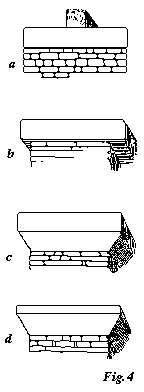92 THE STONES OF VENICE CONSTRUCTION
I am much mistaken if his first impulse would not be to take a great flat stone and lay it on the top; or rather a series of such, side by side, projecting well over the edge of the wall veil. If, also, he proposed to lay a weight (as, for instance, the end of a beam) on the wall, he would feel at once that the pressure of this beam on, or rather among, the small stones of the wall veil, might very possibly dislodge or disarrange some of them; 
§ 3. We must therefore have our flat stone in either case; and let b, Fig. 4, be the section or side of it, as it is set across the wall. Now, evidently, if by any chance this weight happen to be thrown more on the edges of this stone than the centre, there will be a chance of these edges breaking off. Had we not better, therefore, put another stone, sloped off to the wall, beneath the projecting one, as at c? But now our cornice looks somewhat too heavy for the wall; and as the upper stone is evidently of needless thickness, we will thin it somewhat, and we have the form d. Now observe: the lower or bevelled stone here at d corresponds to d in the base (Fig. 2, page 82). That was the foot of the wall; this is its hand. And the top stone here, which is a constant member of cornices, corresponds to the under stone c, in Fig. 2, which is a constant member of bases. The reader has no idea at present of the enormous importance of these members; but as we shall have to refer to them perpetually, I must ask him to compare them, and fix their relations well in his mind: and, for convenience, I shall call the bevelled or sloping stone, X, and the upright-edged stone, Y. The reader may remember easily which is which; for X is an intersection of
[Version 0.04: March 2008]